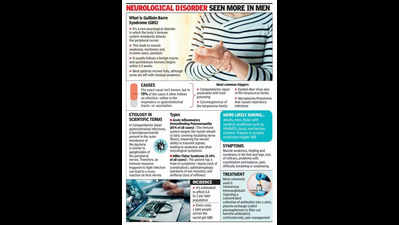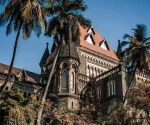For Mumbai, rains trigger rise in Guillain-Barre Syndrome cases | Mumbai News – The Times of India

Mumbai: Between June and Aug every year, doctors in the BMC-run KEM Hospital in Parel notice that alongside a rise in cases of monsoon-related viral and bacterial infections, the load of a debilitating and serious neurological disorder called Guillain-Barre Syndrome (GBS) also rises. GBS, in seven out of 10 cases, follows an infection and causes paralysing weakness.
“With the incidence of respiratory and gastrointestinal infections going up in monsoons, it also marks the peak season for GBS in Mumbai,” said KEM Hospital Dean Dr Sangeeta Ravat, a neurologist by training. As a referral centre that gets patients from across the state, KEM Hospital doctors treat GBS patients throughout the year. “We would, on average, see four new GBS patients every month, but the number goes up to four a week in the peak season,” she said.
At the moment, neighbouring Pune is witnessing a significant GBS outbreak, with 73 affected people, including 14 on ventilator support. Doctors suspect Campylobacter jejuni, a bacterium associated with food poisoning, triggered most of the cases as many reported recent stomach infections. On Saturday, a state public health department doctor said that the GBS curve in Pune is showing a decline.
Unpredictable Condition
The issue with GBS is that unlike the brief respiratory or gastrointestinal infections that precede (or trigger) it, the syndrome itself has no predictable timeframe for recovery. “Some patients may take days or weeks since the start of symptoms to get a full-blown attack, while some may deteriorate in a day,” said Dr Ravat. Consider Kalyan resident Nilesh Abhang, who woke up on Jan 18, 2019, with pain in three fingers on his left hand. He visited his family doctor, who said it wasn’t anything to worry about. “But, in less than 24 hours, I couldn’t move my limbs. Within 48 hours of the finger pain, I was on ventilator support,” said the 36-year-old businessman.
Dr Shraddha More from KEM’s medicine department, who treated Abhang, said GBS is characterised by ascending paralysis, weakness that usually begins in the lower extremities and progressively involves the trunk. In some patients, it affects the chest region, requiring ventilator support. “Abhang had a long recovery period, and each of us felt so relieved when he sent photos of himself riding a bicycle again,” she said.
Some Recover Soon
Kalyan resident Sunil (name changed), a 30-year-old technician with a security firm, had typhoid in Nov-end but didn’t think much of it. “But in mid-Dec, I started noticing that walking was not easy as my feet felt weak. One day, while climbing the stairs at Kalyan station, it was near impossible to lift my feet,” he said. He rushed to Fortis Hospital in Kalyan where neurologist Dr Rakesh Lalla, on listening to his medical history, advised a nerve conduction test that showed the problem. He was immediately put on intravenous immunoglobulin (a collection of antibodies injected into a vein). “Over the next five days, I had 15 units of IVIG,” said Sunil, and before leaving the hospital on Jan 5, he could walk with support.
Dr Lalla said, “The problem with GBS is the initial symptoms are subtle weakening in the legs. An MRI will not reveal any problem, and the patient is likely to be sent back with pain medications.”
Any patient with a history of infection in the last two to three weeks along with muscular weakness in the legs should be asked to undergo a nerve conduction test and/or a lumbar puncture. “There is a lot of myth about the lumbar puncture test that is done to collect cerebrospinal fluid as people wrongly believe one’s lower back will become weaker. CSF proves a GBS infection and ensures treatment can begin at the earliest,” the neurologist added. In Sunil’s case, the entire disorder lasted for about a fortnight, and he is already back at work.
Economic Burden
While GBS isn’t contagious, it represents an autoimmune response affecting the nervous system. Yet, it has emerged as a public health scare in Pune at the moment.
According to medical literature, although rare, with an incidence of 0.4 to 2 per 100,000, GBS has major effects on the healthcare system. According to one estimate, at least 1 lakh new GBS cases are diagnosed every year, and the cost of treating them could run up to $1.7 billion a year.
Many patients need ICU care as well as IVIG injections, whose dosage is determined by the patient’s weight. For instance, Sunil, who weighs 75 kg, had a bill of around Rs 3 lakh. Dr More said that IVIG treatment at public hospitals costs approximately Rs 1 lakh for a 50kg patient. “The state health insurance scheme pays for Rs 50,000 and only the rest has to be raised by the family,” she added.
















